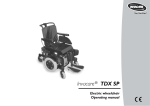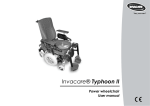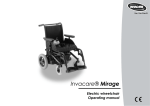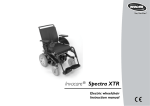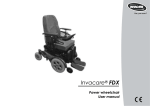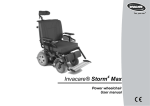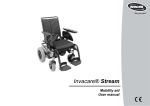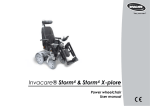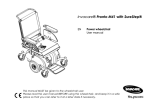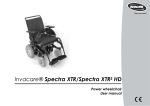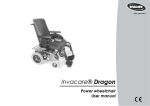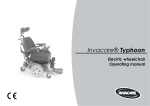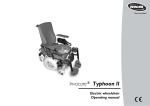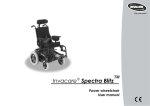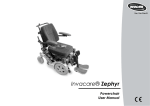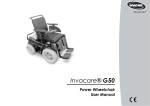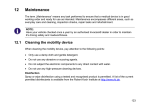Download User Manual
Transcript
Yes, You Can.® Invacare® Storm4 Mobility aid Instruction manual How can you get in touch with Invacare®? If you have any questions or need support, please contact your authorised Invacare® Dealer, who has the necessary know-how and equipment plus the special knowledge concerning your Invacare® product, and can offer you all-round satisfactory service. Should you wish to contact Invacare® directly, you can reach us in Europe at the following addresses and phone numbers. 2 Mobitec Mobilitätshilfen GmbH Herzog Odilostrasse 101 A-5310 Mondsee Austria Fax: @: @: WWW: +43 - 6232 - 55 35 0 +43 - 6232 - 55 35 4 [email protected] [email protected] www.mobitec-austria.com Invacare® n.v. Autobaan 22 B-8210 Loppem (Brugge) Belgium Fax: @: WWW: +32 - (0)50 - 83 10 10 +32 - (0)50 - 83 10 11 [email protected] www.invacare.be Mobitec Rehab AG Benkenstraße 260 CH-4108 Witterswil Switzerland Fax: @: @: WWW: +41 - (0)61 - 48 77 08 0 +41 - (0)61 - 48 77 08 1 [email protected] [email protected] www.mobitec-rehab.ch Invacare Aquatec Alemannenstraße 10 88316 Isny Deutschland Fax @: WWW: 0 75 62 / 7 00 - 251 08 00 / 6 73 81 72 [email protected] www.invacare-aquatec.de Invacare® A/S Sdr. Ringvej 39 DK-2605 Brøndby Danmark (Kundeservice): Fax (Kundeservice): @: WWW: +45 - (0)36 - 90 00 00 +45 - (0)36 - 90 00 01 [email protected] www.invacare.dk Invacare® SA c/ Areny, s/n Poligon Industrial de Celrà 17460 Celrà (Girona) ESPAÑA : Fax: @: WWW: +34 - (0)972 - 49 32 00 +34 - (0)972 - 49 32 20 [email protected] www.invacare.es Invacare® Poirier SAS Route de St Roch F-37230 Fondettes France : Fax : @: WWW: +33 - (0)247 - 62 64 66 +33 - (0)247 - 42 12 24 [email protected] www.invacare.fr Invacare® Ltd South Road Bridgend Industrial Estate Mid Glamorgan - CF31-3PY United Kingdom (Customer Service): +44 - (0)1656 - 664 321 Fax (Customer Service): +44 - (0)1656 - 667 532 @: [email protected] @: [email protected] WWW: www.invacare.co.uk Invacare Mecc San s.r.l. Via Dei Pini, 62 I - 36016 Thiene (VI) ITALIA Fax: @: WWW: Invacare Ireland Ltd. Unit 5 Seatown Business Campus Seatown Rd, Swords County Dublin Ireland Fax: @: Invacare® AS Grensesvingen 9 Postboks 6230 N-0603 Oslo Norge (Kundeservice): Fax (Kundeservice): @: WWW: +39 - 0445 - 38 00 59 +39 - 0445 - 38 00 34 [email protected] www.invacare.it +353 - 18 10 70 84 +353 - 18 10 70 85 [email protected] +47 - (0)22 57 95 10 +47 - (0)22 57 95 01 [email protected] www.invacare.no 3 4 Invacare® B.V. Celsiusstraat 46 NL-6716 BZ Ede The Netherlands : Fax: @: WWW: +31 - (0)318 - 69 57 57 +31 - (0)318 - 69 57 58 [email protected] www.invacare.nl Invacare® PORTUGAL Lda Rua Senhora de Campanhã 105 P-4369-001 Porto PORTUGAL : Fax: @: WWW: +351-225105946 +351-225105739 [email protected] www.invacare.pt Återförsäljare: Invacare® AB Fagerstagatan 9 S-163 91 Spånga Sverige (Kundtjänst): Fax (Kundtjänst): @: @: WWW: +46 - (0) 8 761 70 90 +46 - (0) 8 761 81 08 [email protected] [email protected] www.invacare.se Tillverkare: Invacare® Deutschland GmbH Kleiststraße 49 D-32457 Porta Westfalica Deutschland MÖLNDAL Fax: @: +46 - (0) 31 – 86 36 00 +46 - (0) 31 – 86 36 06 [email protected] LANDSKRONA Fax: @: +46 - (0) 418 – 285 40 +46 - (0) 418 – 180 89 [email protected] OSKARSHAMN Fax: @: +46 - (0) 491 – 101 40 +46 - (0) 491 – 101 80 [email protected] Table of Contents Chapter 1 Introduction 1.1 1.2 1.3 1.4 1.5 1.6 2 5 17 General Safety Notes ..............................................................................................................17 Safety information with regard to care and maintenance ...................................................20 Safety Information on Electromagnetic Interference...........................................................21 Safety Information on Driving and Freewheel Mode............................................................22 Safety information regarding changes and modifications to the mobility device............24 Safety Information on Wheelchairs with a Lifter ..................................................................25 Safety Information on Wheelchairs with Recaro Seats .......................................................27 Key features Getting in and out of the wheelchair 4.1 4.2 4.3 10 Important symbols in this manual .........................................................................................12 Important symbols found on the vehicle ..............................................................................13 Type classification and permissible use...............................................................................15 Guarantee .................................................................................................................................15 Indications................................................................................................................................16 Life expectancy........................................................................................................................16 Safety Notes 2.1 2.2 2.3 2.4 2.5 2.6 2.7 3 4 Page 28 29 Removing the armrests to get in ...........................................................................................29 Information about getting in and out.....................................................................................30 Using the cane holder .............................................................................................................31 Driving 32 5 5.1 5.2 5.3 5.4 6 Pushing the mobility device in freewheel mode 6.1 7 8 8.2 8.3 8.4 37 Disengaging motors................................................................................................................37 Remotes Adjusting the wheelchair to the user's seating posture 8.1 6 Before driving for the first time..............................................................................................32 Parking and stationary............................................................................................................33 Taking Obstacles.....................................................................................................................34 5.3.1 Maximum obstacle height .............................................................................................34 5.3.2 Safety information when ascending obstacles .............................................................34 5.3.3 The correct way to overcome obstacles .......................................................................34 Driving up and down gradients..............................................................................................35 39 40 Adjusting the armrests and the joystick box........................................................................41 8.1.1 Adjusting the joystick box to the length of the user's arm (all seats)............................41 8.1.2 Adjusting the height of the remote (only for foldable remote holders)..........................42 8.1.3 Swivelling the remote to the side..................................................................................43 8.1.4 Changing the arm support position...............................................................................44 8.1.5 Setting the height of the armrests.................................................................................45 8.1.6 Adjusting the width of the armrests ..............................................................................46 Adjusting the seat angle .........................................................................................................47 8.2.1 Electric ..........................................................................................................................47 8.2.2 Manual ..........................................................................................................................47 Adjusting the backrest............................................................................................................49 8.3.1 Adjusting the backrest angle using the perforated plate (standard seat) .....................49 8.3.2 Adjusting the back seat angle on the Easy-Adapt seating system...............................50 8.3.3 Electric ..........................................................................................................................50 8.3.4 Manual ..........................................................................................................................50 8.3.5 Adjusting the tension adjustable backrest upholstery ..................................................51 Adjusting the headrest............................................................................................................52 8.5 8.6 8.7 8.8 8.9 8.10 9 8.4.1 Adjusting the position of the headrest or neckrest .......................................................53 8.4.2 Adjusting the height of the headrest or neckrest ..........................................................54 8.4.3 Adjusting the position of the headrest with cheek support sideways ...........................55 8.4.4 Adjusting the cheek supports .......................................................................................56 Postural belts ...........................................................................................................................57 8.5.1 Types of postural belts..................................................................................................57 8.5.2 Adjusting the postural belt correctly..............................................................................58 The Lifter ..................................................................................................................................59 Adjusting the trunk support (Easy-Adapt seating system).................................................60 8.7.1 Adjusting the width........................................................................................................60 8.7.2 Adjusting the height ......................................................................................................61 8.7.3 Adjusting the depth .......................................................................................................62 Adjusting and removing the tray ...........................................................................................63 8.8.1 Laterally adjusting the tray............................................................................................63 8.8.2 Adjusting the depth of the tray / removing the tray.......................................................64 8.8.3 Swinging the tray away to the side ...............................................................................64 Seat support.............................................................................................................................66 8.9.1 Adjusting seat width......................................................................................................66 8.9.1.1 Exploded drawing of seat support ...........................................................................67 8.9.2 Adjusting the seat depth ...............................................................................................69 8.9.2.1 Exploded drawing of seat support ...........................................................................71 8.9.2.2 Adjusting the seat depth without replacing the seat support plate ..........................72 8.9.2.3 Adjusting the seat depth with replacing the seat support plate ...............................73 Backrest unit with ergonomic length compensation...........................................................75 8.10.1 Adjusting the width........................................................................................................75 Adjusting footrests and legrests 9.1 77 Centre-mounted legrests ........................................................................................................77 9.1.1 Electric legrest ..............................................................................................................77 9.1.1.1 Lowering the electric legrest completely to assist getting out of the wheelchair.....78 9.1.2 Adjustable legrest .........................................................................................................81 7 9.2 8 Adjusting the angle ..................................................................................................81 9.1.2.1 9.1.2.2 Adjusting the length of the legrest ...........................................................................82 9.1.2.3 Adjusting the calf plate to the calf width of the user ................................................83 9.1.2.4 Adjusting the angle of the foot plate ........................................................................84 Legrests or footrests attached to the side............................................................................85 9.2.1 Vari-F footrest ...............................................................................................................85 9.2.1.1 Swivelling the footrest outward and/or removing.....................................................85 9.2.1.2 Setting the angle......................................................................................................86 9.2.1.3 Setting the end stop of the footrest .........................................................................88 9.2.1.4 Adjusting the length of the footrest..........................................................................91 9.2.2 Vari-A legrests ..............................................................................................................92 9.2.2.1 Swivelling the legrest outward and/or removing......................................................92 9.2.2.2 Setting the angle......................................................................................................93 9.2.2.3 Setting the end stop of the legrest...........................................................................95 9.2.2.4 Adjusting the length of the legrest ...........................................................................98 9.2.2.5 Adjusting the depth of the calf plate ........................................................................99 9.2.2.6 Adjusting the height of the calf plate .....................................................................100 9.2.2.7 Unlocking and swivelling the calf plate backward when alighting .........................101 9.2.2.8 Adjusting the angle adjustable foot plate...............................................................102 9.2.2.9 Adjusting the angle and depth adjustable foot plate .............................................103 9.2.3 ADE legrests...............................................................................................................104 9.2.3.1 Swivelling the legrest outward and/or removing....................................................104 9.2.3.2 Setting the angle....................................................................................................105 9.2.3.3 Adjusting the length of the legrest .........................................................................106 9.2.3.4 Adjusting the depth of the calf plate ......................................................................107 9.2.3.5 Adjusting the height of the calf plate .....................................................................108 9.2.3.6 Unlocking and swivelling the calf plate backward when alighting .........................109 9.2.3.7 Adjusting the angle adjustable foot plate...............................................................110 9.2.3.8 Adjusting the angle and depth adjustable foot plate .............................................111 9.2.4 Angle-adjustable footboard.........................................................................................112 10 Electrical System 10.1 10.2 Electronics Protection System ............................................................................................114 Batteries .................................................................................................................................115 10.2.1 What you need to know about batteries .....................................................................115 10.2.2 Charging the batteries ................................................................................................117 10.2.3 How to handle damaged batteries correctly ...............................................................118 11 Maintenance 11.1 11.2 11.3 13 14 15 16 119 Cleaning the mobility device ................................................................................................119 Inspection checks .................................................................................................................120 11.2.1 Before each use of the mobility device.......................................................................121 11.2.2 Weekly ........................................................................................................................122 11.2.3 Monthly .......................................................................................................................123 Repair Instructions................................................................................................................124 11.3.1 Reparing a flat tyre .....................................................................................................124 11.3.2 Repairing a flat tyre (front) ..........................................................................................125 11.3.3 Repairing tyre punctures (drive wheel).......................................................................128 12 Transport 12.1 12.2 114 131 Transferring the wheelchair to a vehicle.............................................................................131 Securing the wheelchair for transport without passengers .............................................132 Refurbishment Disposal Technical Specifications Inspections Performed 133 133 134 137 9 1 Introduction Dear user, First we would like to thank you for purchasing our product! We hope that you will have a great deal of pleasure with your new power chair This operating manual contains important information and notes about: • Safety • Operation • Care and maintenance. Please take care to read the operating manual thoroughly before starting out on your first journey. This wheelchair has been constructed for a large circle of users with different requirements. The decision whether the model is suitable for the user may only be taken by medical specialists with appropriate expertise. Invacare® or their statutory representatives can accept no liability in cases in which the wheelchair has not been adapted to suit the users’ handicaps. Some maintenance and settings can be carried out by the user or his attendants. Certain adjustments do however require technical training and may only be carried out by your Invacare® specialist dealer. Damages and errors caused by nonobservance of the operating manual or as a result of incorrect maintenance are excluded from all guarantees. 10 This manual contains copyrighted information. This manual may not be reproduced or reprinted either partly or completely without previous written consent from Invacare® or its statutory representatives. We reserve the right to make any necessary alterations on the grounds of technical improvements. 11 1.1 Important symbols in this manual WARNING! This symbol warns you of danger! • Always follow these instructions to avoid injury to the user or damage to the product! EXPLOSION HAZARD! This symbol warns you of an explosion hazard, an example of which can be caused by excessive tyre pressure in a pneumatic tyre! • Always follow the instructions to avoid injury to the user or damage to the product! BURN HAZARD! This symbol warns you of burns due, for example, to leaking battery acid! • Always follow the instructions to avoid injury to the user or damage to the product! NOTE: This symbol identifies general information which is intended to simplify working with your product and which refers to special functions. Requirements: • This symbol identifies a list of various tools, components and items which you will need in order to carry out certain work. If you do not have available all of the tools listed, do not attempt to perform the operation. The results could be potentially dangerous. 12 1.2 Important symbols found on the vehicle This product has been supplied from an environmentally aware manufacturer that complies with the Waste Electrical and Electronic Equipment (WEEE) Directive 2002/96/CE. This product may contain substances that could be harmful to the environment if disposed of in places (landfills) that are not appropriate according to legislation. • The 'crossed out wheelie bin' symbol is placed on this product to encourage you to recycle wherever possible. • Please be environmentally responsible and recycle this product through your recycling facility at its end of life. This symbol indicates the position of an anchoring point for use with a Tie-Down System. If the symbol appears on a bright yellow sticker, then the anchoring point is suitable for fixation of the wheelchair in a vehicle for use as a vehicle seat. This symbol indicates the maximum width to which an armrest may be adjusted. Pulling the armrest out further can cause it to fall out of it's fixation. For further information, see chapter "Adjusting the width of the armrests" on page 46. 13 If the electric wheelchair is fitted with a table, it is imperative that it is removed and safely stowed when transporting the wheelchair in a vehicle! 14 1.3 Type classification and permissible use This vehicle was designed for persons whose ability to walk is impaired, but who are still physically and mentally able to operate an electric vehicle. It has been classified according to EN 12184 as a class B mobility product (for indoor and outdoor areas). It is therefore compact and agile enough for indoor areas, but also able to overcome many obstacles in outdoor areas. You can find exact information on speed, turning radius, range, safe climbing ability, maximum obstacle height and permissible operating conditions in chapter "Technical Specifications" on page 134. Please also pay attention to all safety information in chapter "Safety Notes" starting from page 17. The vehicle was successfully tested according to German and international standards as to its safety. It was also tested successfully according to EN60529 IPX4 as to its resistance to spray water, and is therefore well suited for typical middle European weather conditions. When equipped with an appropriate lighting system, the vehicle is suitable for use on public roads. 1.4 Guarantee The terms and conditions of the guarantee are part of the general terms and conditions particular to the individual countries in which this product is sold. 15 1.5 Indications The use of this mobility product is recommended for the following indications: The inability or a greatly restricted ability to walk within the scope of the basic requirement to be able to move within one’s own four walls. The need to leave the dwelling place in order to get some fresh air during a short walk or to reach those places generally to be found at close distance to the dwelling and where everyday business is carried out. Provision of electric wheelchairs for interior and exterior areas is advisable if the use of handoperated wheelchairs is no longer possible on account of the disability, yet proper operation of an electromotive drive unit is still practicable. 1.6 Life expectancy We estimate a life expectancy of five years for this product, provided it is used in strict accordance with the intended use as set out in this document and all maintenance and service requirements are met. The estimated life expectancy can be exceeded if the product is carefully used and properly maintained, and provided technical and scientific advances do not result in technical limitations. The life expectancy can also be considerably reduced by extreme or incorrect usage. The fact that we estimate a life expectancy for this product does not constitute an additional warranty. 16 2 Safety Notes • READ WELL BEFORE OPERATION! 2.1 General Safety Notes Danger of injury if mobility device is used in any other way than the purpose described in this manual! • Only ever use the mobility device in accordance with the instructions in this User's Manual (see Chapter "Type classification and permissible use" on Page 15)! • Pay strict attention to the safety information! Danger of injury if the mobility device is driven when ability to operate a vehicle is impaired by medication or alcohol! • Never drive the mobility device under the influence of medication or alcohol! If necessary, the mobility device must be operated by an attendant who is physically and mentally able! Danger of damage or injury if mobility device is accidentally set into motion! • Switch the mobility device off before you get in, get out or handle unwieldy objects! • When the drive is disengaged, the brake inside the drive is deactivated. For this reason, pushing the mobility device by an attendant is only recommended on flat surfaces, never on gradients. Never leave your mobility device on a gradient with its motors disengaged. Always re-engage the motors immediately after pushing the mobility device r(see Chapter "Pushing the mobility device in freewheel mode" on Page 37)!! 17 Danger of injury if the mobility device is switched off while driving, for example by pressing the On/Off Button or disconnecting a cable, due to it coming to an abrupt, sharp stop! • If you have to brake in an emergency, simply release the joystick which will bring you to a halt! (please Refer to the joystick operating manual for more information). Danger of injury when transferring mobility device to a vehicle for transport with the occupant seated in it! • It is always better to transfer the mobility device to a vehicle without the occupant seated in it! • If the mobility device needs to be loaded up a ramp together with its driver, ensure that the ramp does not exceed the maximum safe slope (see Chapter "Technical Specifications" from Page 134 • If the mobility device does need to be loaded using a ramp which exceeds the maximum safe slope (see Chapter "Technical Specifications" from Page 134), then you must use a winch! An attendant can safely monitor and assist the loading process! • As an alternative you can use a platform left! Ensure that the total weight of the mobility device including the user does not exceed the maximum permissible weight for the platform if you are using! Danger of injury if maximum permissible load is exceeded! • Do not exceed the maximum permissible load ((see Chapter "Technical Specifications" from Page 134))! • The mobility device is only designed for use by a single occupant! Never use the mobility device to transport more than one person! 18 Danger of injury due to wrong lifting or dropping of heavy components! • When maintaining, servicing or lifting any part of your mobility device, take into account the weight of the individual components especially the batteries! Be sure at all times to adopt the correct lifting posture and ask for assistance if necessary! Danger of falling out of the mobility device. • Do not slide forward on the seat, do not lean forward between your knees, do not lean backwards out over the top of the backrest, for example to reach an object. • If a posture belt is installed, it should be correctly adjusted and used them each time you use the mobility device. • When transferring to a different seat, position the mobility device as close as possible to the new seat. Danger of injury by moving parts! • Make sure that no injury is incurred by moving parts of the mobility device, like wheels or one of the Lifter Modules (if fitted), especially when children are around! Danger of fire or breaking down due to electric devices being connected! • Do not connect any electric devices to your mobility device that are not expressly certified by Invacare® for this purpose! Have all electrical installations done by your authorised Invacare® Dealer! 19 2.2 Safety information with regard to care and maintenance Danger of accident and loss of guarantee if maintenance is insufficient! • For reasons of safety and in order to avoid accidents which result from unnoticed wear, it is important that this electric mobility product undergoes an inspection once every year under normal operating conditions (see inspection plan contained in service instructions)! • Under difficult operating conditions such as daily travel on steep slopes, or in the case of use in medical care cases with frequently changing wheelchair users, it would be expedient to carry out intermediate checks on the brakes, accessories and running gear! • If the mobility product is to be operated on public roads, the vehicle driver is responsible for ensuring that it is in an operationally reliable condition! Inadequate or neglected care and maintenance of the mobility product will result in a limitation of the manufacturer's liability! 20 2.3 Safety Information on Electromagnetic Interference This electric vehicle was successfully tested in accordance with International standards as to its compliance with Electromagnetic Interference (EMI) Regulations. However, electromagnetic fields, such as those generated by radio and television transmitters, and cellular phones, can influence the functions of electric vehicles. Also, the electronics used in our vehicles can generate a low level of electromagnetic interference, which however will remain within the tolerance permitted by law. For these reasons we ask you to please observe the following precautions: WARNING: Danger of malfunction due to electromagnetic interference! • Do not switch on or operate portable transceivers or communication devices (such as radio transceivers or cellular phones) when the vehicle is switched on! • Avoid getting near strong radio and television transmitters! • In case the vehicle should be set in motion unintentionally or the brakes are released, switch it off immediately! • Adding electrical accessories and other components or modifying the vehicle in any way can make it susceptible to electromagnetic interference. Keep in mind that there is no sure way to determine the effect such modifications will have on the overall immunity of the electronic system! • Report all occurrences of unintentional movement of the vehicle, or release of the electric brakes to the manufacturer! 21 2.4 Safety Information on Driving and Freewheel Mode Danger of injury if the wheelchair tips over! • Inclines and declines can only be travelled up to the maximum safe slope (please see Chapter "Technical Specifications" from Page 134). • Always return the backrest of your seat or the seat tilt to an upright position before ascending slopes! We recommend that you position the seat backrest and the seat tilt (if fitted) slightly to the rear before descending slopes! • Only ever drive downhill at a maximum of 2/3 of the top speed! Avoid abrupt braking or accelerating on gradients! • If at all possible, avoid driving on slippery surfaces (such as snow, gravel, ice etc.) where there is a danger of you losing control over the vehicle, especially on a gradient! If driving on such a surface is inevitable, then always drive slowly and with the utmost caution! • Never attempt to overcome an obstacle when on an uphill or downhill gradient! • Never attempt to drive up or down a flight of steps with your wheelchair! • When overcoming obstacles, always observe the maximum obstacle height (see Chapter "Technical Specifications" from page 134 and information about overcoming obstacles in Chapter "Taking Obstacles" from page 34. • Avoid shifting your centre of gravity as well as abrupt joystick movements and changes of direction when the wheelchair is in motion! • Never use the wheelchair to transport more than one person! • Do not exceed the overall maximum permissible load or the maximum load per axle (please see chapter "Technical Specifications" on page 134.). • Note that the wheelchair will brake or accelerate if you change the Driving Mode whilst the wheelchair is in motion! 22 Danger of breaking down in adverse weather conditions, i.e. extreme cold, in an isolated area! • If you are a user with severely limited mobility, we advise that in the case of adverse weather conditions DO NOT attempt a journey without an accompanying attendant! Danger of injury if your foot slides off the footrest and gets caught underneath the wheelchair when it is in motion! • Make sure each time before you drive the wheelchair that your feet are squarely and securely in place on the footplates, and that both legrests are properly locked into place! Danger of injury if you collide with an obstacle when driving through narrow passages such as doorways and entrances! • Drive through narrow passages in the lowest Driving Mode and with due caution! If your electric wheelchair has been fitted with angle-adjustable legrests, there is a danger of personal injury and damage to the wheelchair if you drive the wheelchair with the legrests raised! • To avoid unwanted displacement of the wheelchair centre of gravity to the front (especially when travelling downhill) and in order to avoid damage to the wheelchair, angle-adjustable legrests must always be lowered during normal travelling. CAUTION: Danger of tipping! Anti tip wheels (stabilisers) are only effective on firm ground! They sink in on soft ground such as grass, snow or mud if the electrical vehicle rests itself on them. They lose their effect and the electrical vehicle can tip over. • Only drive with extreme care on soft ground, especially during uphill and downhill journeys. In the process pay increased attention to the tip stability of the electric vehicle. 23 2.5 Safety information regarding changes and modifications to the mobility device CAUTION: Danger of injuries and damage to mobility aid due to unauthorised components and accessory parts! Seating systems, additions and accessory parts which have not been authorised by Invacare® for use with this mobility aid can affect the tipping stability and increase tipping hazards! • Only ever use seating systems, additions and accessory parts which have been authorised by Invacare® for this mobility aid! Electrical and electronic components which have not been authorised by Invacare® for use with this mobility aid can cause fire hazards and lead to electromagnetic damage! • Only ever use electrical and electronic components which have been authorised by Invacare® for this mobility aid! Batteries which have not been authorised by Invacare® for use with this mobility aid can cause chemical burns! • Only ever use batteries which have been authorised by Invacare® for this mobility aid! 24 2.6 Safety Information on Wheelchairs with a Lifter IMPORTANT - IF YOUR WHEELCHAIR IS EQUIPPED WITH A LIFTER: Danger of injury if the wheelchair tips over! • Never exceed the maximum permissible load (see Technical Specifications)! • Avoid dangerous driving situations when the lifter is in a raised position, such as trying to overcome obstacles like kerbs or driving up or down steep gradients! • Never lean out of the seat when the lifter is raised! • Inspect the lifter module at least once a month to make sure the automatic speed reduction function, which reduces the speed of the wheelchair when the lifter is raised, is working properly (see chapter on lifter)! Notify your authorised dealership immediately if it is not working properly! Danger of injury by moving parts! • Never let objects get caught in the space underneath a raised lifter! • Make sure that neither you nor anyone else is injured by placing hands, feet other body extremities under the raised seat! Danger of malfunction of the Lifter Module! • Inspect the lifter module at regular intervals to make sure there are no foreign objects or visible damage, and to make sure the electric plugs are firmly inserted into their sockets! CAUTION! Damage to mobility aid caused by one-sided loading on lifter pillar! • One-sided loading occurs if the seat is raised and/or tilted. Always return your seat backrest to the upright position and the seat tilting to the horizontal position before ascending slopes! ! Never subject the lifter pillar to continuous single-sided loading! The raising and tilting function of the seat only provides additional rest positions. 25 Important information regarding speed reduction with raised lifter! If the lifter has been raised above a certain point, the drive electronics considerably reduces the speed of the mobility aid. If speed reduction has been activated, drive mode can only be used to carry out minor movements of the mobility aid and not for regular driving! To drive normally, please lower the lifter until the speed reduction has been deactivated again! 26 2.7 Safety Information on Wheelchairs with Recaro Seats Danger of injury if the wheelchair tips over! The centre of gravity of a Recaro seat is higher than that of other seats. The Recaro seat is also heavier than other seating systems. The backrests of RECARO seats can be leaned back 90°. For these reasons there is an increased risk of tipping over! • Never lean the backrest backward more than 30° degrees, and never exceed 15° when driving the wheelchair! More than 30° NEVER!! 15°-30° Standstill! 0°-15° Driving 27 3 Key features 1) Headrest 2) Backrest 3) Armrest 4) Battery case (rear) 5) Drive wheel 6) Drive motor (with engaging lever) 7) Remote 8) Legrests 9) Castor wheel 28 4 Getting in and out of the wheelchair Important information for getting into and out of the wheelchair from the side! The armrest must be removed in order to get into or out of the wheelchair from the side. 4.1 Removing the armrests to get in If you want to get out on the side where the remote is installed, you can disconnect the remote cable from the remote (depending on your version). Removing the armrest: • The remote cable can be disconnected from the remote depending on the remote version. • Loosen clamping lever (1) • Remove the side panel from the receptacle 29 4.2 Information about getting in and out Getting into the wheelchair: • Position your wheelchair as close as possible to your seat. This might have to be done by an attendant. • Switch your wheelchair off. • Apply the hand brake of your wheelchair (if existing). • Detach the side part of your wheelchair or swivel it up. • Now slide into the wheelchair. Getting out of the wheelchair: • Drive your wheelchair as close as possible to your seat. • Switch your wheelchair off. • Apply the hand brake of your wheelchair (if existing). • Detach the side part of your wheelchair or swivel it up. • Now slide onto your new seat. NOTE: If you do not have sufficient muscle strength, you should ask other persons for help. Use a sliding board, if possible. 30 4.3 Using the cane holder If your mobility device is fitted with a cane holder, then this can be used to safety transport your walking cane or crutches with you wherever you go. The cane holder consists of a lower plastic holder and an upper Velcro fastener. CAUTION! Injury hazard! Transporting a walking cane or crutches laying loosely across the user's lap or in an otherwise unsecured fashion can pose an injury risk to the user and bystanders! • Always use a cane holder to transport a cane or crutches! • Open the upper Velcro fastener. • Place the bottom end of the cane or crutch in the lower holder. • Use the upper Velcro fastener to secure the cane or crutch in place. 31 5 Driving NOTE The maximum load capacity that is stated in the technical data only states that the system is designed for this mass in total. However, this does not mean that one can sit a person with this body weight in the wheelchair without restrictions. Attention must be paid to the body proportions, such as height, weight distribution, abdominal girth, leg and calf girth and seat depth. These factors have a strong influence on driving features such as tilt stability and traction. The permissible axle loads in particular must be adhered to (see chapter "Technical Specifications" as from page 134)! It may possibly be necessary to carry out adaptations to the seat system. 5.1 Before driving for the first time... Before you take your first trip, you should familiarise yourself well with the operation of the vehicle and with all operating elements. Take your time to test all functions and driving modes. NOTE: If installed, make sure to properly adjust and use the posture belt each time you use the wheelchair. Sitting Comfortably = Driving Safely Before each trip, make sure that: 32 • You are within easy reach of all operating controls. • The battery charge is sufficient for the distance intended to be covered. • The posture belt (if installed) is in perfect order. • 5.2 The rear mirror (if fitted) is fitted so that you can always look behind you without having to lean forward or change your seat position in any way. Parking and stationary When parking your vehicle or if your vehicle is stationary for a prolonged period: • Switch the vehicle's power system off (ON-/OFF key). • Activate your anti-theft lock, if existing. 33 5.3 Taking Obstacles 5.3.1 Maximum obstacle height You can find information about maximum obstacle heights in the chapter entitled "Technical Specifications" from page 134. 5.3.2 Safety information when ascending obstacles CAUTION: Danger of Tipping Over! • Never approach obstacles at an angle! • Put your backrest into an upright position before climbing an obstacle! 5.3.3 The correct way to overcome obstacles Ascending and descending The same approach applies to both ascending and descending obstacles: Right • Approach the obstacle or the kerb slowly and at a right angle. • Stop shortly before the front wheels come into contact with the obstacle. • Check the position of the front wheels. They must be in driving direction and at right angles to the obstacle! • Approach slowly and keep at a consistent speed until the rear wheels have also passed over the obstacle. 34 Wrong 5.4 Driving up and down gradients For information concerning the maximum safe slope, please see chapter "Technical Specifications" starting on page 134. WARNING: Danger of tipping over! • Only ever drive downhill at a maximum of 2/3 of the top speed! Avoid sudden changes of direction or abrupt braking when driving on slopes! • Always return the backrest of your seat or the seat tilt (if adjustable seat tilt is available) to an upright position before ascending slopes! We recommend that you position the seat backrest or the seat tilt slightly to the rear before descending slopes! • If the lifter (if installed) is raised drive mode is only used for positioning and not for regular drive operation! Lower the lifter before ascending or descending a slope! • Never attempt to ascend or descend a slope on slippery surfaces or where there is a danger of skidding (such as wet pavement, ice etc)! • Avoid trying to get out of the vehicle on an incline or a gradient! • Always drive straight in the direction the road or path you are on goes, rather than attempting to zigzag! • Never attempt to turn around on an incline or a slope! Braking distance is much longer on a downhill slope than on even terrain! • Never drive down a slope that exceeds the maximum safe slope (see Chapter "Technical Specifications" on Page 134)! 35 IMPORTANT INFORMATION ABOUT REGULATING THE ACTUATOR FUNCTIONS ON GRADIENTS Your mobility aid is fitted with an angular sensor which guarantees tipping stability. The sensor measures the actual angle of the drive unit, and prevents any further decrease in stability by restricting the functionality of the adjustment actuators. If this safety function is activated, the backrest and the seat tilting can only be moved forwards, and the lifter can only be lowered. Please reposition your mobility aid on level ground so that the actuators can function normally again. 36 6 Pushing the mobility device in freewheel mode The motors of the wheelchair are equipped with automatic brakes, preventing that the wheelchair starts rolling out of control when the joystick box is switched off. When pushing the wheelchair manually whilst freewheeling, the magnetic brakes must be disengaged. NOTE: Pushing the wheelchair by hand may require more physical force than expected (more than 100 N). 6.1 Disengaging motors Danger of the vehicle running away! • When the motors are disengaged (for push operation whilst freewheeling), the electromagnetic motor brakes are deactivated! When the vehicle is parked, the levers for engaging and disengaging the motors must without fail be locked firmly into the "DRIVE" position (electromagnetic motor brakes activated)! Each motor is fitted with an engaging lever which is used to engage or disengage the motor. 37 Disengaging the motor: • Switch off remote. • Pull the engaging lever (1) upwards. The motor is disengaged. Engaging the motor: • Push the engaging lever down (1). The motor is engaged. Please note that both motors must always be engaged before driving! 38 7 Remotes Your wheelchair may be equipped with one of several different remotes. For information on the different functions and how to operate a particular remote, please see it's corresponding User Guide. 39 8 Adjusting the wheelchair to the user's seating posture CAUTION: Damage to wheelchair and accident hazard! Collisions between the legrests and the chassis, or between the footplates and the floor, can occur due to different combinations of adjustment options! • When adjusting the seat angle, lifter and legrests, ensure that the legrests cannot collide with the wheelchair chassis, and that the footplates cannot collide with the floor! Electrical adjustment options Please refer to the instruction manual for your remote for more information on operating electrical adjustment options. Recaro® Seats For more information on a Recaro® seat, please see the separate User Guide that comes with the Recaro® seat. Note Initial setup should always be done by a healthcare professional. Adjustment by the user is only recommended after they have been given appropriate guidance by the healthcare professional. 40 8.1 Adjusting the armrests and the joystick box The following information is valid for all seating systems. CAUTION: Danger of the remote being pushed backwards during an accidental collision with an obstacle, such as a doorframe or table, and the joystick being jammed against the armpad if the position of the remote is adjusted and all screws are not completely tightened! This will cause the mobility device to drive forward uncontrollably and potentially injure the mobility device user and any person standing in the way! • When adjusting the position of the remote, always make sure to tighten all screws securely! • If this should accidentally happen, immediately switch the mobility device electronics OFF at the remote! 8.1.1 Adjusting the joystick box to the length of the user's arm (all seats) • Release wing bolt (1). • Adjust the remote by pushing it forwards or backwards to the required location. • Retighten the screw. 41 8.1.2 Adjusting the height of the remote (only for foldable remote holders) Pre-requisites: • 1x 6 mm Allen key • Unscrew screw (1) with Allen key. • Adjust remote to required height. • Retighten the screw. 42 8.1.3 Swivelling the remote to the side If your wheelchair is fitted with a swing-away remote bracket, then the remote can be moved away to the side, for example to drive up close to a table. 43 8.1.4 Changing the arm support position Requirements: • 1x Allen key 3 mm The arm support has 12 possible positions. • To change the position of the arm support, loosen the screw (1) and remove it. • The position of the arm support is adjusted by selecting a combination of screw holes in the arm support and the drillholes in the fixing plate. • Reposition the screws and tighten. 44 8.1.5 Setting the height of the armrests Requirements: • Allen key 3 mm • Unscrew screw (1) with Allen key. • Adjust armrest to required height. • Retighten the screw. 45 8.1.6 Adjusting the width of the armrests WARNING! Serious injury hazard if one of the armrests falls out of its bracket because they have been adjusted to a width which exceeds the permissible value! • The width adjustment is fitted with small stickers with markings and the word "STOP"! The armrests must never be pulled out further than the point at which the word "STOP" is completely legible! • Always tighten the fixing screws properly once adjustments have been completed! Requirements: • Allen key 8 mm Carrying out adjustments • Loosen screw (1) • Adjust armrest to required position. • Retighten the screw. • Repeat this procedure for the second armrest. 46 8.2 Adjusting the seat angle CAUTION! Adjusting the seat tilt or the backrest angle changes the geometry of the mobility device and directly influences its dynamic stability! • For details regarding dynamic stability, negotiating gradients and obstacles and the correct adjustment of seat tilt or backrest angle, please see chapters "Taking Obstacles" on page 34 and "Driving up and down gradients " on page 35. 8.2.1 Electric Please consult the instruction manual for your remote for information about electric adjustment. 8.2.2 Manual The seat angle is adjusted using an adjusting mechanism, which consists of 2 perforated strips which can be pushed against each other. The adjusting mechanism is at the front under the seat frame. When adjusting the seat angle, please ensure that both fixing screws are always used to fix the adjusting mechanism! Note Activate the motor brakes (engage motor) before adjusting the seat angle!. Only adjust the seat angle manually if nobody is sitting in the seat! Pre-requisites: • 1x 6 mm Allen key 47 • Switch the power supply off (ON/OFF key). • Unscrew Allen screws (1). • Adjust the seat angle by raising or lowering the seat. • Insert the Allen screws again and tighten. 48 8.3 Adjusting the backrest CAUTION! Adjusting the seat tilt or the backrest angle changes the geometry of the mobility device and directly influences its dynamic stability! • For details regarding dynamic stability, negotiating gradients and obstacles and the correct adjustment of seat tilt or backrest angle, please see chapters "Taking Obstacles" on page 34 and "Driving up and down gradients " on page 35. 8.3.1 Adjusting the backrest angle using the perforated plate (standard seat) • Unscrew the handscrews (1) on both sides. • The backrest can be set by selecting a combination of one of the two drillholes in the backrest frames and one of the six drillholes in the fixing plate. • Reposition the screws and tighten. 49 8.3.2 Adjusting the back seat angle on the Easy-Adapt seating system 8.3.3 Electric Please consult the instruction manual for your remote for information about electric adjustment. 8.3.4 Manual • Adjust the angle by turning the handwheel (1). 50 8.3.5 Adjusting the tension adjustable backrest upholstery • Remove the backrest cushion (attached with Velcro strips) by pulling it up and off to access the adjustment straps. • Adjust the tension of the individual straps as desired. • Replace the backrest cushion. 51 8.4 Adjusting the headrest CAUTION: Injury hazard when using the mobility aid as a vehicle seat if a headrest is wrongly adjusted or not installed! The neck can be hyperextended during collisions! • A headrest must be installed! The optionally available headrest supplied by Invacare® for this wheelchair is perfectly suitable for use during transport. Headrests from third-party manufacturers may also be used for this purpose. • The headrest must be adjusted to the user's ear height! 52 8.4.1 Adjusting the position of the headrest or neckrest The adjustment of the position is the same for all headrests and neckrests. Pre-requisites: • Allen key 5 mm • Loosen the screws (1, 2) or the clamping lever (3). • Adjust the headrest or neckrest to the required position. • Retighten screws and clamping lever. 53 8.4.2 Adjusting the height of the headrest or neckrest The adjustment of the height is the same for all headrests and neckrests. • Loosen the thumb screw (1). • Adjust the headrest or neckrest to the required height. • Retighten thumb screw. 54 8.4.3 Adjusting the position of the headrest with cheek support sideways Pre-requisites: • Allen key 5 mm • Loosen the Allen screw (1) • Slide the headrest left or right to the required position. • Retighten the Allen screw. 55 8.4.4 Adjusting the cheek supports • Push the cheek supports inward or pull them out to the required position. 56 8.5 Postural belts A postural belt is an option which can either be fixed to the wheelchair ex-works or can be retrofitted by your specialist dealer. If your wheelchair is fitted with a postural belt, your specialist dealer will have informed you about fitting and usage. The postural belt is used to help the wheelchair user keep an optimum sitting position. Correct use of the belt assists the user in sitting securely, comfortably and well-positioned in the wheelchair, especially for such users who do not have such a good sense of balance while sitting. NOTE: We recommend using the postural belt whenever the wheelchair is used. The belt should be tight enough to ensure that you are sitting comfortably and that your body is in the correct sitting position. 8.5.1 Types of postural belts Your wheelchair can be fitted with the following postural belt types ex-works. If your wheelchair has been fitted with a different belt to those listed below, please ensure that you have received the manufacturer's documentation with regard to correct fitting and use. Belt with metal buckle, adjustable one side Belt can only be adjusted on one side which can result in the buckle not sitting centrally. 57 Belt with metal buckle, adjustable both sides Belt can be adjusted on both sides. This means that the buckle can be centrally positioned. Belt with Velcro fastening Adjustments are made using the Velcro fastening. For this reason no buckle is required on this belt. 8.5.2 Adjusting the postural belt correctly • Ensure that you are sitting correctly, which means that you are sitting right at the back of the seat, your pelvis is positioned erect and as symmetrically as possible, not to the front, to the side or at one edge of the seat. • Position the postural belt so that your hipbones can be easily felt above the belt. • Adjust the belt length using one of the adjustment aids described above. The belt should be adjusted so that you can fit a flat hand between the belt and your body. • The buckle should be positioned as centrally as possible. In doing so, please carry out adjustments on both sides as much as possible. • Please check your belt every week to ensure that it is still in good working condition; to ensure it has no damage or wear, and that it is fixed properly to the wheelchair. If the belt is only fastened with a bolted connection, ensure that the connection has not loosened or undone. You can find more information about maintenance work on belts in the service manual, which is available from Invacare®. 58 8.6 The Lifter The electric lifter is operated from the remote. Please refer to the remote manual for more information. Information regarding operation of the lifter at temperatures of less than 0 °C Our wheelchairs are fitted with safety mechanisms that prevent capacity overload of the electronic components. At operating temperatures below freezing point this can, in particular, lead to the lifter actuator being shut down after approx. 1 second operating time. The lifter can be raised or lowered gradually by repeatedly operating the joystick. In many cases this generates sufficient heat for the actuator to operate as normal. Note - speed limiter The lifter is fitted with sensors which reduce the mobility device speed as soon as the lifter is raised above a certain point. This takes place to guarantee the tipping stability of the mobility device and to avoid damage to the legrests. If the speed limit is activated, a corresponding blink code is displayed on the remote. Please refer to the remote manual for more information. To reapply normal speed, run the lifter down until the status display stops blinking. 59 8.7 Adjusting the trunk support (Easy-Adapt seating system) The trunk supports can be adjusted in width, height and depth. 8.7.1 Adjusting the width • Loosen the handscrews (1). • Adjust the trunk support to the required width. • Retighten the handscrews again. 60 8.7.2 Adjusting the height Requirements: • Allen key 5 mm • Undo the height adjustment Allen screws (1). • Set the trunk support to the required height. • Retighten the screw. 61 8.7.3 Adjusting the depth Requirements: • Allen key 5 mm • Open the zip. • Undo the screws (1) for the depth adjustment. • Adjust the trunk support to the required width. • Retighten the bolts. • Close the zip again. 62 8.8 Adjusting and removing the tray CAUTION: Injury hazard or material damage if an electric wheelchair which is fitted with a table is transported in a vehicle! • If a table is fitted, always remove it before transporting the wheelchair! 8.8.1 Laterally adjusting the tray • Loosen the wing-screw (1). • Adjust the tray towards the left or right. • Re-tighten wing-screw. 63 8.8.2 Adjusting the depth of the tray / removing the tray • Loosen the wing-screw (1). • Adjust the table to the desired depth (or remove it entirely). • Re-tighten the screw. 8.8.3 Swinging the tray away to the side The tray can be swivelled up and away to the side to allow the user to get in and out of the mobility device CAUTION! Risk of injury! When the tray is raised it does not lock in place in this position! • Do not tilt the tray up and leave it leaning in this position! • Never attempt to drive with the tray tilted up! • Always lower the tray in a controlled manner! 64 The tray can be swivelled upwards and pushed to the side as illustrated to enable getting on and off. 65 8.9 Seat support 8.9.1 Adjusting seat width Note Please also refer to the following chapter entitled "Adjusting the seat depth". The seat width can be adjusted in stages between 38 and 53 cm. Requirements: • 4 mm Allen key 66 8.9.1.1 Exploded drawing of seat support 67 • Remove the seat cushion. • Remove the cover plates (1). • Undo the two Allen screws (6) at the rear on the crossmember and remove them. • Undo the two Allen screws (9) at the front on the seat support plate and remove them. • Loosen the four Allen screws (7) and (8) which are located at the front and back to the sides of the seat support plate to release tension so that the plate can be moved more easily. Do not, however, remove these screws completely. • Pull or push the seat support plate (2) the required width. A scale (3) has been fitted to the bottom part of the seat support. Use this scale to read off the seat width in centimetres. • Repeat these operations on the other side of the seat. • Now tighten all the screws again. 68 8.9.2 Adjusting the seat depth Note Please also refer to the previous chapter entitled "Adjusting the seat width". The seat depthcan be adjusted in stages between 38 and 53 cm. Requirements: • 4 mm Allen key • 8 mm jaw spanner • oblique pliers • cable binder Note Particular holes in the seat support must be used to the screws depending on the required seat depth. It may also be necessary to replace the seat support plate. • Please use the following figures and the table to determine which holes need to be used for the required seat depth, and therefore whether the seat support plate needs to be replaced or not. 69 Seat depth in cm 70 38 Holes used in front seat frame order no.: 1524550 6&7 Holes used in rear seat frame Seat support plate required order no.: 1524555 A&B SHORT A&C order no. 1526437 A&C 41 5&7 43 4&6 43 4&6 A&C 46 3&5 A&C 48 2&4 A&C 48 2&4 A&C 51 1&3 A&C 53 1&2 B&C MEDIUM order no. 1526438 LONG order no. 1526439 8.9.2.1 Exploded drawing of seat support 71 • Adjust the seat depth as described in the following chapter: - If the seat support plate does not need to be replaced, please refer to Chapter 8.9.2.2. - If the seat support plate does need to be replaced, please refer to Chapter 8.9.2.3. 8.9.2.2 Adjusting the seat depth without replacing the seat support plate • Remove the armrests. • Remove the seat cushion. • Remove the cover plates (1). • Undo and remove the two Allen screws (8) which are located on the side at the rear of the seat support plate, and connect these to the crossmembers (4). • Repeat these operations on the other side of the seat. • Undo and remove the two Allen screws (5) including washers. Assembly: • Pull the seat support to the required length so that the Allen screws (5) can be inserted in the holes in accordance with the table (see above). • Insert the Allen screws (5) including washers again and tighten them. • Fit the two Allen screws (8) which are located at the rear of the seat support, and connect them with the crossmembers (4). You must be using other holes within the 3 hole pairs for the screws than you did during dismantling. • Refit all the parts you have removed. 72 8.9.2.3 Adjusting the seat depth with replacing the seat support plate Disassembly: • Remove the legrests. • Remove the armrests. • Remove the seat cushion. • Remove any cable ties which hold cables from the remote or lighting which have been fitted. Remove the cables from any clips which have been glued on. • Undo the cap nuts on the headlight holders with an 8 mm jaw spanner. • Place the headlights including their holders safely on the rear section of the battery box cover. • Remove the cover plates (1). • Undo the two Allen screws (9) at the front on the seat support plate and remove them. • Undo the two Allen screws (7) which are located on the side at the front of the seat support plate, and connect these to the crossmembers (4). • Undo the two Allen screws (8) which are located on the side at the rear of the seat support plate, and connect these to the crossmembers (4). • Remove the seat support plate (2). • Repeat these operations on the other side of the seat. • Undo and remove the two Allen screws (5) including washers. Assembly: • Pull the seat support to the required length so that the Allen screws (5) can be inserted in the holes in accordance with the table (see above). 73 • Insert the Allen screws (5) including washers again and tighten them. • If necessary, replace the seat support plate (2) in accordance with the table (see above). • Put the seat support plate (2) back in position. • Fit the two Allen screws (7) which are located at the front of the seat support, and connect them with the crossmembers (4). • Fit the two Allen screws (8) which are located at the rear of the seat support, and connect them with the crossmembers (4). It may be necessary to use other holes in the 3 hole pairs for the screws than you did while dismantling the old plate. • Fit the two Allen screws (9) at the front of the seat support plate. • Refit all the parts you have removed. 74 8.10 Backrest unit with ergonomic length compensation 8.10.1 Adjusting the width Note Please also refer to the previous chapter entitled "Adjusting the seat width". The seat can be adjusted in width between 38 and 53 cm as standard. Requirements: • 4 mm Allen key • Remove the backrest cushion. 75 • Loosen the three Allen screws (1). Do not, however, remove these screws completely. • Push the plate (2) as far as required until the required width in cm can be read off the scale (3). • Tighten the three Allen screws again. • Repeat these operations on the other backrest plate. • Attach a backrest cushion of the required width. 76 9 Adjusting footrests and legrests 9.1 Centre-mounted legrests 9.1.1 Electric legrest Please consult the instruction manual for your remote for information about electric adjustment. The electric legrest can be lowered completely to assist getting out of the wheelchair. To do so, move your seat into the correct position by lowering the lifter or by means of a negative seat angle (tilted slightly to the front). 77 9.1.1.1 Lowering the electric legrest completely to assist getting out of the wheelchair Warning! Misuse may destroy the legrest. • Please read and carefully follow the instructions below. Getting in/out of the wheelchair • Set the lifter and tilt to a comfortable position. • Put your feet on the footplate and pull the lever (1). The footplates will move smoothly down to the floor. • Now you can get in/out of the wheelchair. 78 Lifting up the footplates • You are sitting in the wheelchair. • Put your feet beside the footplates. • Pull the lever (1). The footplates rise up automatically. • Let go the lever (1) and put your feet on the footplates. 79 Warning! Danger of damage to the legrest! • Always make sure that the footplates are fully raised to the uppermost position before adjusting the angle of the legrest! • Disregarding this advice will cause damage to your legrest. Adjusting the legrest • Now you can adjust the angle of the legrest. 80 9.1.2 Adjustable legrest 9.1.2.1 Adjusting the angle Prerequisites: • 1x 10 mm open-ended spanner • Use the open-ended spanner to loosen the counternut (1). • Move the legrest to the desired position by turning the spindle (2). • Tighten the counternut. 81 9.1.2.2 Adjusting the length of the legrest Prerequisites: • 1x 5 mm socket head spanner • Use the socket head spanner to loosen the fastening screws (1). • Slide the foot support to the desired height. • Tighten the fastening screws. 82 9.1.2.3 Adjusting the calf plate to the calf width of the user The calf plate of the legrest can be adapted to the user’s calf width by bending apart or together. • Bending the calf plate to the desired width. 83 9.1.2.4 Adjusting the angle of the foot plate Prerequisites: • 1x 5 mm socket head spanner • Fold up the foot plates in order to access the adjusting screws. • Use the socket head spanner to adjust the adjusting screws (1). • Fold the foot plate down again. 84 9.2 Legrests or footrests attached to the side 9.2.1 Vari-F footrest 9.2.1.1 Swivelling the footrest outward and/or removing The small unlocking button is located on the upper section of the footrest. When the footrest is unlocked, it can be swivelled inward or outward when getting into the wheelchair as well as being removed completely. • Press the unlocking button (1) and swivel the footrest outward. • Remove the footrest in an upward direction. 85 9.2.1.2 Setting the angle PLEASE NOTE: Danger of injury due to incorrect adjustment of the footrests and legrests. • Before and during every journey it is imperative to ensure that neither the legrests nor the steering wheels contact the ground! Requirements: • 1x Allen key 6 mm • metal drift with maximum 4 mm diameter • hammer • Loosen the screw (1) using the Allen key. • If the footrest cannot be moved after loosening the screw, position a metal pin in the designated borehole (2) and use a hammer to knock on this lightly. The clamping mechanism in the interior of the footrest will be released by this. Repeat the procedure from the other side of the footrest if necessary. 86 • Loosen the screw (1) using the Allen key. • Set the desired angle. • Re-tighten the screw. 87 9.2.1.3 Setting the end stop of the footrest Pre-requisites: • 1x 6 mm Allen key • 1x 10 mm open-ended spanner The end position of the footrest is determined by means of a rubber stop (1). The rubber stop can be screwed in or out (A) or pushed up or down (B). 88 • Use the Allen key to loosen the screw (1) and swivel the footrest upward in order to access the rubber stop. • Use the open-ended spanner to loosen the counternut (1). 89 • Move the rubber stop to the desired position • Re-tighten the counternut • Move the footrest to the desired position. • Re-tighten the screw. 90 9.2.1.4 Adjusting the length of the footrest PLEASE NOTE: Danger of injury due to incorrect adjustment of the footrests and legrests. • Before and during every journey it is imperative to ensure that neither the legrests nor the steering wheels contact the ground! Pre-requisites: • 1x 5 mm Allen key • Use the spanner to loosen the screw (1). • Adjust to the desired length. • Re-tighten the screw. 91 9.2.2 Vari-A legrests 9.2.2.1 Swivelling the legrest outward and/or removing The small unlocking button is located on the upper section of the legrest. When the legrest is unlocked, it can be swivelled inward or outward when getting into wheelchair as well as being removed completely. • Press the unlocking button (1) and swivel the legrest outward. • Remove the legrest in an upward direction. 92 9.2.2.2 Setting the angle PLEASE NOTE: Danger of injury due to incorrect adjustment of the footrests and legrests. • Before and during every journey it is imperative to ensure that neither the legrests nor the steering wheels contact the ground! • Loosen the hand screw (1). • Loosen the fixing mechanism by tapping lightly against the handscrew. 93 • Set the required angle. • Retighten the handscrew (1) again. 94 9.2.2.3 Setting the end stop of the legrest Pre-requisites: • 1x 10 mm open-ended spanner The end position of the legrest is determined by means of a rubber stop (A). The rubber stop can be screwed in or out (A) or pushed up or down (B). 95 • Disengage the release handle (1) and swivel the legrest upward in order to access the rubber stop. • Use the open-ended spanner to loosen the counternut (1). 96 • Move the rubber stop to the desired position • Re-tighten the counternut • Move the footrest to the desired position. • Re-tighten the release handle. 97 9.2.2.4 Adjusting the length of the legrest PLEASE NOTE: Danger of injury due to incorrect adjustment of the footrests and legrests. • Before and during every journey it is imperative to ensure that neither the legrests nor the steering wheels contact the ground! Pre-requisites: • 1x 6 mm Allen key • Use the spanner to loosen the screw (1). • Adjust to the desired length. • Re-tighten the screw. 98 9.2.2.5 Adjusting the depth of the calf plate The depth of the calf plate can be adjusted via the holding plate. The holding plate hole combinations allow 5 different depth settings. Pre-requisites: • 1x 10 mm open-ended spanner • Use the open-ended wrench to loosen the nut (1) and remove. • Adjust to the desired depth. Please observe that the round holes are intended for the calf plate retaining screw and the oblong holes for the aglet without thread. • Screw the nut back on and tighten. 99 9.2.2.6 Adjusting the height of the calf plate Pre-requisites: • 1x 4 mm Allen key • Use the Allen key to loosen the screws (1). • Adjust to the desired position. • Re-tighten the screws. 100 9.2.2.7 Unlocking and swivelling the calf plate backward when alighting • Press the calf plate straight down. • Unlock the legrest and swivel outward. The calf plate swivels backward on its own. 101 • Lift leg over the heel strap and place on the ground. 9.2.2.8 Adjusting the angle adjustable foot plate Pre-requisites: • 1x 5 mm Allen key • Use the Allen key to loosen both set screws on the foot plate. • Adjust to the desired angle. • Re-tighten the screws. 102 9.2.2.9 Adjusting the angle and depth adjustable foot plate Pre-requisites: • 1x 5 mm Allen key • Use the Allen key to loosen the set screw on the foot plate (1). • Adjust the foot plate to the desired angle or depth. • Re-tighten the screw. 103 9.2.3 ADE legrests 9.2.3.1 Swivelling the legrest outward and/or removing The small unlocking button is located on the upper section of the legrest. When the legrest is unlocked, it can be swivelled inward or outward when getting into wheelchair as well as being removed completely. • Press the unlocking button (1) and swivel the legrest outward. • Remove the legrest in an upward direction. 104 9.2.3.2 Setting the angle PLEASE NOTE: Danger of crushing! • Do not reach inside the swivelling range of the legrest! PLEASE NOTE: Danger of injury due to incorrect adjustment of the footrests and legrests. • Before and during every journey it is imperative to ensure that neither the legrests nor the steering wheels contact the ground! The electrically height-adjustable legrests are operated using the remote. Please see the separate operating manual for your remote for more information. 105 9.2.3.3 Adjusting the length of the legrest PLEASE NOTE: Danger of injury due to incorrect adjustment of the footrests and legrests. • Before and during every journey it is imperative to ensure that neither the legrests nor the steering wheels contact the ground! Pre-requisites: • 1x 10 mm open-ended spanner • Use the spanner to loosen the screw (1). • Adjust to the desired length. • Re-tighten the screw. 106 9.2.3.4 Adjusting the depth of the calf plate The depth of the calf plate can be adjusted via the holding plate. The holding plate hole combinations allow 5 different depth settings. Pre-requisites: • 1x 10 mm open-ended spanner • Use the open-ended wrench to loosen the nut (1) and remove. • Adjust to the desired depth. Please observe that the round holes are intended for the calf plate retaining screw and the oblong holes for the aglet without thread. • Screw the nut back on and tighten. 107 9.2.3.5 Adjusting the height of the calf plate Pre-requisites: • 1x 4 mm Allen key • Use the Allen key to loosen the screws (1). • Adjust to the desired position. • Re-tighten the screws. 108 9.2.3.6 Unlocking and swivelling the calf plate backward when alighting • Press the calf plate straight down. • Unlock the legrest and swivel outward. The calf plate swivels backward on its own. 109 • Lift leg over the heel strap and place on the ground. 9.2.3.7 Adjusting the angle adjustable foot plate Pre-requisites: • 1x 5 mm Allen key • Use the Allen key to loosen both set screws on the foot plate. • Adjust to the desired angle. • Re-tighten the screws. 110 9.2.3.8 Adjusting the angle and depth adjustable foot plate Pre-requisites: • 1x 5 mm Allen key • Use the Allen key to loosen the set screw on the foot plate (1). • Adjust the foot plate to the desired angle or depth. • Re-tighten the screw. 111 9.2.4 Angle-adjustable footboard Requirements: • Torx open-ended spanner T25 • Allen key 5 mm • Release the screws (1) with the Torx spanner and remove. • Adjust to required width. • Retighten the bolts. • Glue the anti-slip rubber mat to the footboard. 112 • Loosen the locking screw(1) on both sides with the mm Allen key. • Adjust the footboard to the required angle. • Retighten the bolts. 113 10 Electrical System 10.1 Electronics Protection System The vehicle drive electronics is fitted with an overload protection. If the drive is severely overloaded over a long period (e.g. during steep climbs) and, above all, at simultaneous high external temperatures, the electronic system can overheat. In this case, the vehicle performance is gradually reduced until it comes to a standstill. The status display shows a corresponding blink code (please refer to the instruction manual for your remote). If you switch the drive electronics off and then on again, the error message is deleted and the electronics can be switched on again. It can however take up to five minutes until the electronics has cooled down enough for the drives to apply their full performance. If the drive is blocked due to an insurmountable obstacle, for example a kerb or similar which is too high, and the driver attempts to run the drive for more than 20 seconds against this obstacle, the electronic system switches the drives off to avoid damage. The status display shows a corresponding flash code (please refer to your remote instruction manual). If you switch the drive electronics off and then on again, the error message is deleted and the electronics can be switched on again. NOTE A defective main fuse may be replaced only after checking the entire electric system. An Invacare® specialised dealer must perform the replacement. You can find information on the fuse type in chapter "Technical Specifications" starting on page 134. 114 10.2 Batteries 10.2.1 What you need to know about batteries Power is supplied by two 12V batteries. The batteries are maintenance-free and only need regular charging. New batteries should always be fully charged once before their first use. New batteries will be at their full capacity after having run through approx. 10 - 20 charging cycles. How fast the batteries will be discharged will depend on many circumstances, such as ambient temperature, condition of the surface of the road, tyre pressure, weight of the driver, way of driving and utilisation of lighting, etc. 115 NOTE The batteries supplied with your electric vehicle are not hazardous goods. This classification is based on the German GGVS Hazardous Goods Road Transport Ordinances, and the IATA/DGR Hazardous Goods Rail Transport / Air Transport Ordinances. Batteries may be transported without restrictions, whether by road, rail or by air. Individual transport companies have, however, guidelines which can possibly restrict or forbid certain transport procedures. Please ask the transport company regarding each individual case. Pay attention to the Battery Charge Indicator! Make sure to charge the batteries when the Battery Charge Indicator shows that battery charge is low. We recommend charging the batteries after each trip, as well as each night over night. Depending on the level of discharge, it can take up to 12 hours until the batteries are fully charged again. Protect your charger from sources of heat such as heaters and direct sunlight. If the battery charger overheats, charging current will be reduced and the charging process delayed. To avoid damaging the batteries, never allow them to be fully discharged. Do not drive on heavily discharged batteries if it is not absolutely necessary, as this will strain the batteries unduly and shorten their life expectancy. In case your vehicle is not used for a longer period of time, then the batteries must be charged at least once a month to maintain a full charge. Alternatively, the vehicle can stay connected to the charger. The batteries cannot be overcharged with the specified charger. Please use only charging devices in Class 2. This class of chargers may be left unattended during charging. All charging devices which are supplied by Invacare® comply with these requirements. 116 10.2.2 Charging the batteries Please see the instruction manuals for your remote and battery charger for the position of the charging socket and further information about charging the batteries. WARNING: Danger of explosion and destruction of batteries if the wrong battery charger is used! • Only ever use the battery charger supplied with your vehicle, or a charger that has been approved by Invacare®! Danger of electric shock and damage to the battery charger if it is allowed to get wet! • Protect the battery charger from water! • Always charge in a dry environment! Danger of short circuit and electric shock if the battery charger has been damaged! • Do not use the battery charger if it has been dropped or damaged! Danger of fire and electric shock if a damaged extension cable is used! • Only ever use an extension cable if it is absolutely necessary! In case you must use one, make sure it is in good condition! • Switch off the electric wheelchair at the remote. Connect the battery charger to the remote. The charging soccer is located underneath the remote. • Connect the battery charger to the power supply and switch on if necessary. • Once charging is complete, first disconnect the battery charger from the power supply, then disconnect the plug from the remote. 117 10.2.3 How to handle damaged batteries correctly WARNING: Corrosion and burns from acid leakage if batteries are damaged! • Remove clothes that have been soiled by acid immediately! After contact with skin: • Immediately wash affected area with lots of water! After contact with eyes: • Immediately rinse eyes under running water for several minutes; consult a physician! • Always wear appropriate safety clothing when handling damaged batteries. • Place damaged batteries in an acid-resistant receptacle immediately after removing them. • Only ever transport damaged batteries in an appropriate acid-resistant receptacle. • Wash all objects that have come into contact with acid with lots of water. Disposing of dead or damaged batteries correctly Dead or damaged batteries can be given back to your dealer or directly to Invacare®. 118 11 Maintenance The term „Maintenance“ means any task performed to ensure that a medical device is in good working order and ready for use as intended. Maintenance encompasses different areas, such as everyday care and cleaning, inspection checks, repair tasks and refurbishment. NOTE: Have your vehicle checked once a year by an authorised Invacare® dealer in order to maintain it's driving safety and roadworthiness. 11.1 Cleaning the mobility device When cleaning the mobility device, pay attention to the following points: • Only use a damp cloth and gentle detergent. • Do not use any abrasive or scouring agents. • Do not subject the electronic components to any direct contact with water. • Do not use any high-pressure cleaning devices. Disinfection Spray or wipe disinfection using a tested and recognised product is permitted. A list of the current permitted disinfectants is available from the Robert Koch Institute at http://www.rki.de. 119 11.2 Inspection checks The following tables list inspections which need to be carried out at the appropriate intervals. If the mobility device should not pass one of these inspections, please read the appropriate chapter and follow the instructions contained there, or contact an authorised Invacare® dealer. Please refer to the service manual for this mobility device for an extensive list of inspections and instructions for upkeep. You can order a service manual from Invacare®. This does, however, contain instructions for specially trained service technicians and describes working operations which are not intended to be carried out by the end user. 120 11.2.1 Before each use of the mobility device Component Inspection Horn Lighting unit • • Batteries • If inspection is not passed • Notify dealer • Notify dealer Check of correct mode of operation. Check of correct operating mode for all lights such as indicators, headlights and rear lights. Check of battery charging status. Please • refer to the remote manual for information about battery charging status display. Charge the batteries (see chapter "Charging the batteries" on page 117). 121 11.2.2 Weekly Component Armrests /side panels • Tyres (pneumatic) • • Inspection Check to ensure that the armrests can be correctly inserted in the holders and do not wobble. Check the correct tyre condition. Check the correct tyre pressure. • • • • • Tyres (punctureproof) 122 • Check the correct tyre condition. • If inspection is not passed Tighten the screw or camping lever to fix the armrests (see chapter "Adjusting the armrests and the joystick box" on page 41). Notify dealer Notify dealer Inflate the tyres to the correct pressure(see chapter "Technical Specifications" on page 134). Repair the inner tube if the tyres are flat (see chapter "Repair Instructions" on page 124) or notify your dealer for repair. Notify dealer 11.2.3 Monthly Item All upholstered parts • Removable legrests • • Castors Drive wheels • • Electronics and connectors • Inspection check Check for damage and wear. Check whether the legrests can be fixed securely and whether the loosening mechanism is properly operable (see chapter "Adjusting footrests and legrests" on page 77). Check that all adjustment options function properly (see chapter "Adjusting footrests and legrests" on page 77). Check that castors rotate and swivel freely. Check that the drive wheels rotate without wobbling. It is easiest to have someone stand behind the mobility device and observe the drive wheels as you drive away from them to do this. Check all cables for damage and all connecting plugs for snug fit. • • Action Contact your dealer. Contact your dealer. • Contact your dealer. • • Contact your dealer. Contact your dealer. • Contact your dealer. 123 11.3 Repair Instructions Important information about maintenance work tools! Some maintenance work which is described in this manual and can be carried out by the user without problems require the correct tools for proper work. If you do not have the correct tool available we do not recommend that you try to carry out the relevant work. In this case, we urgently recommend that you contact an authorised specialist workshop. The following are instructions on maintenance and repairs that can be performed by the user. For the specifications of spare parts please see "Technical Specifications" on page 134, or consult the Service Manual, available from Invacare® (in this connection please see the addresses and phone numbers in section "How can you get in touch with Invacare®?" on page 2). In case you require assistance, please contact your Invacare® Dealer. 11.3.1 Reparing a flat tyre WARNING: Danger of damage or injury if the vehicle is accidentally set into motion during repairs! • Switch the power off (ON/OFF Button)! • Engage the motors! • Secure the vehicle against rolling away by placing wedges under the wheels! 124 11.3.2 Repairing a flat tyre (front) Requirements: • Allen key 5 mm • Open-end spanner 24 mm • Repair kit for inner tubes or a new inner tube. • Talcum powder Remove the wheel • Jack the vehicle up and place a block of wood underneath it to prop it up. • Remove the plastic cap (1). • Loosen and remove the nut (2) using the openend spanner. • Remove the washer (3). • Take the wheel off of the fork assembly. NOTE Re-assembly is done in reverse order. Make sure that the wheel is put back on the same side it was on, and that it runs in the same direction it did before it was removed. 125 Repair the flat tyre • Remove the valve cap. • Let the air out of the tyre completely by pressing the pin in the centre of the valve in. • Remove the 5 Allen screws (1) • Take the tyre and the inner tube off of the rim halves. • Repair the inner tube and re-fit, or replace it with a new one. NOTE In case the old inner tube is to be repaired and used again, and it happens to get wet during repair, then it is easier to re-fit it if you powder it lightly with talcum powder. 126 • Place the rim halves in the tyre from the outside. • Pump up the tyre a little. • Re-position the Allen screws in the rim and tighten them firmly. Make sure the inner tube does not get pinched between the rims halves! • Check to make sure that the tyre is squarely in place on the rim. • Pump up the tyre to the recommended tyre pressure. • Check to make sure that the tyre is still squarely and snugly in place on the rim. • Screw the valve cap back on. • Refit the wheel. 127 11.3.3 Repairing tyre punctures (drive wheel) Injury hazard! If the wheel has been insufficiently tightened during assembly, it can become loosened during driving! • When reassembling the drive wheels, tighten the Allen screws at a torque of 30 Nm! • Secure all screws using a suitable blocker (e.g. Loctite 243)! Requirements: • Allen key – open-ended spanner 6 mm • Torque wrench • Repair kit for tyre repair or a new inner tube • Talcum powder • Screw blocker Loctite (e.g. Loctite 243) Removing the wheel • Block up the vehicle (place wooden blocks under frame). • Unscrew the screw (1). • Remove the wheel from the hub. 128 NOTE Re-assembly is done in reverse order. Ensure that the tyre is replaced on the same side and in the same travel direction as it was previously mounted. Repairing the flat tyre EXPLOSION HAZARD! The wheel will explode if you do not let the air out of the tyre before removing the wheel! • Always let the air out of the tyre before removing it (press in the pin in the middle of the valve)! • Unscrew valve cap. • Depressurise tyre completely by pressing in the pin in the valve . • Remove the 5 cylinder head screws (back of the wheel, 2. • Remove the rim halves from the tyre. • Remove the inner tube from the tyre. • Repair inner tube and replace, or insert new. NOTE If the old inner tube is to be repaired and re-used, and has become wet during repair, you can make replacement easier by sprinkling the inner tube with a little talcum powder. 129 • Insert the wheel rim halves from outside into the tyre. • Pump a little air into the inner tube. • Reinsert the cylinder head screws and tighten to10 Nm. Avoid crushing the inner tube! • Ensure that the tyre outer is seated correctly. • Pump the tyre up to the prescribed pressure. • Ensure that the tyre outer is seated correctly again. • Screw the valve cap back on. • Refit the wheel. 130 12 Transport CAUTION! Injury hazard! The presence of a restraint system on a wheelchair under no circumstances implies that the wheelchair can be used as a vehicle seat! • This wheelchair meets the requirements of ISO 7176/19-2001 and may under no circumstances be used as a vehicle seat or for the transport of the user in a vehicle! • Using a wheelchair which does not meet these criteria as a vehicle seat can lead to serious injuries or death if a traffic accident occurs! 12.1 Transferring the wheelchair to a vehicle WARNING: Danger of tipping over, if the wheelchair is transferred to a vehicle using a ramp that exceeds the maximum safe slope, or if the backrest is not in an upright position during transfer! • If the wheelchair has to be transferred to a vehicle using a ramp that exceeds the maximum safe slope (see Chapter "Technical Specifications" starting on page 134), then a winch must be used! An attendant can then safely oversee and assist the transfer process! • If no winch is installed, then the wheelchair must not be transferred to a vehicle using a ramp that exceeds the maximum safe slope! • Alternatively, a tail lift installed in the vehicle may be used! • Only ever transfer the wheelchair to a vehicle with the backrest in an upright position! Ensure that the total weight of the mobility aid including the user does not exceed the highest permissible weight for the platform lift! • Only ever run the wheelchair with the seat back in the upright position, seat lifter lowered and the seat tilting in the upright position into the transport vehicle (please refer to Chapter "Driving up and down gradients " on Page 35)! 131 12.2 Securing the wheelchair for transport without passengers CAUTION: Injury hazard! • If you are unable to fasten your electric wheelchair securely in a transport vehicle, we recommend that you do not transport it! • Before transporting your wheelchair, make sure the motors are engaged and that the Joystick Box is switched off. • We urgently recommend securing the wheelchair to the floor of the transporting vehicle. 132 13 Refurbishment The product is suitable for refurbishment. Actions to be carried out: • Cleaning and disinfection. Please see chapter "Maintenance" on page 119. • Inspection according to service plan. Please consult service instructions, available from Invacare®. • Adaptation to the user. Please see chapter "Adjusting the wheelchair to the user's seating posture" on page 40. 14 Disposal • The equipment wrapping is potentially recyclable. • The metal parts are used for scrap metal recycling. • The plastic parts are used for plastic recycling. • Electric components and printed circuit boards are disposed of as electronic scrap. • Disposal must be carried out in accordance with the respective national legal provisions. • Ask your city or district council for details of the local waste management companies. 133 15 Technical Specifications Permissible Operating and Storage Conditions Temperature range for operation according to ISO 7176-9: Temperature range for storage according to ISO 7176-9: Electrical system Motors Batteries Main fuse • -40 … +65 °C 300 W (6 km/h) 300 W (10 km/h) 2 x 12V / 70 Ah 80 A Charging device Output current Output voltage Input voltage Operating temperature (surroundings) Storage temperature -20° ... +50°C Tyres Tyre pressure • 2.8 bar Driving characteristics 134 • • • • • -25 … +50 °C 8A ± 8% 24V nominal (12 cells) 230 – 240V -5° ... +40°C Driving characteristics Speed Max. safe slope Max. climable obstacle height (with kerb climber) Max. climable obstacle height (without kerb climber) Turning radius • 6 / 10 km/h • 10.5 % (6°) Stat. / 14% (8°) Dyn. • 10 cm • 6 cm • 83 cm (without legrests) • 111 cm (with legrests) Drive range in accordance with ISO 7176** Driving range • 36 km Dimensions Total height Drive unit width Total length (incl. standard footrests) Total length (without footrests) Seat height *** (with lifter) Seat height *** (without lifter) Seat width Seat depth Backrest height *** Standard • 97 cm • 63 cm • 110 cm Easy-Adapt • 106 cm • 63 cm • 110 cm Matrix • 97 cm • 63 cm • 110 cm Recaro • 97 cm • 63 cm • 110 cm • • • • • • • • • • • • • • • • • • • • • • • • 87 cm 40 - 65 cm 45 / 48 cm 38 - 53 cm 38 - 53cm 48 / 54 cm 87 cm 40 - 65 cm 45 / 48 cm 38 - 53 cm 38 - 53cm 50 cm 87 cm 40 - 65 cm 45 / 48 cm 38 - 53 cm 38 - -53 cm 50 cm 87 cm 40 - 65 cm 45 / 48 cm 49 - 53 cm 46 - 51cm 77 - 83 cm 135 Dimensions Backrest angle Foot support length Seat angle, electrical adjustment Seat angle, manual adjustment Standard • -10°, 0°, +7.5°, +15°, +22.5°, +30° • 25-34 / 2938 cm • 29 - 47 cm • 0° - 25° • 0° - 9° Weight Kerb weight **** • at least 174kg Loading Max. load • 150 kg Axle loads Max. front axle load Max. rear axle load • 200 kg • 300 kg Armrest height Easy-Adapt • -5°...+35° Matrix • -5°...+35° Recaro • 0°...+45° • 25-34 / 2938 cm • 29 - 47 cm • 0° - 25° • 0° - 9° • 25-34 / 2938 cm • 29 - 47 cm • 0° - 25° • 0° - 9° • 25-34 / 2938 cm • 29 - 47 cm • 0° - 25° • 0° - 9° ** Width adjustable for side panel adjustment ** Note: The drive range of an mobility aid is strongly influenced by external factors, such as the charging state of the batteries, surrounding temperature, local topography, road surface characteristics, tyre pressure, weight of driver, drive style and use of batteries for lighting, servos etc. *** Measured without seat cushion **** The actual kerb weight depends on the fittings your mobility aid has been supplied with. Every Invacare® mobility aid is weighed when leaving the works. Please refer to the nameplate for the kerb weight (including batteries) measured. 136 16 Inspections Performed It is confirmed by stamp and signature that all jobs listed in the inspection schedule of the Service and Repair Instructions have been properly performed. The list of the inspection jobs to be performed can be found in the Service Manual which is available through Invacare®. Delivery Inspection 1st Annual Inspection Stamp of authorised Dealer / Date / Signature Stamp of authorised Dealer / Date / Signature Stamp of authorised Dealer / Date / Signature Stamp of authorised Dealer / Date / Signature Stamp of authorised Dealer / Date / Signature Stamp of authorised Dealer / Date / Signature 2nd Annual Inspection 4th Annual Inspection 3rd Annual Inspection 5th Annual Inspection 137 138 English Order No. of this Manual: 1529686.DOC Release Date: 19.06.09











































































































































